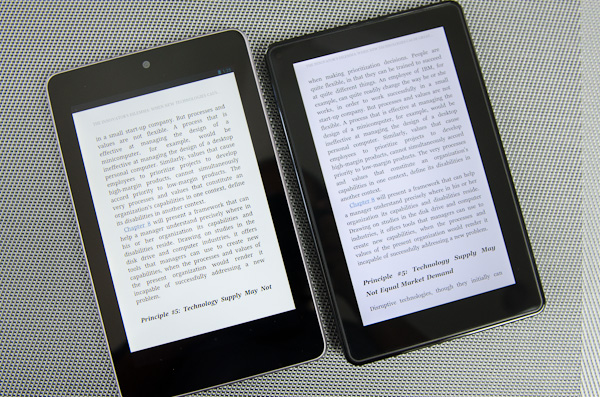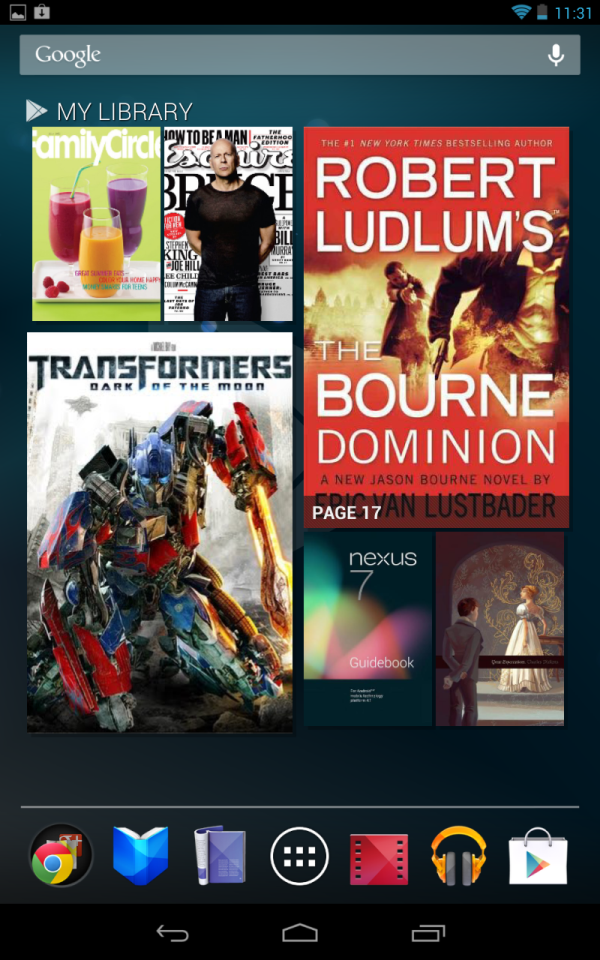The Google Nexus 7 Review
by Anand Lal Shimpi & Brian Klug on July 26, 2012 11:35 AM ESTAndroid 4.1
In the process of working on the Nexus 7 review I dusted off (literally) my Kindle Fire, powered it up and checked for updates expecting to find tons. I found none. The Kindle Fire is still running 6.3.1, released a few months ago, and more importantly it's still relying on the CPU for a lot of drawing, which means the UI isn't smooth. Scrolling in Amazon's Silk Browser is fast, but only because the Kindle Fire drops a lot of animation frames. The experience is jarring, and much better on the Nexus 7 by comparison.
While the Kindle Fire's OS looks like a polished, previous generation of Android, Android 4.1 delivers much of the smoothness of the iPad's iOS. Don't get me wrong, there are still some rough edges and hiccups. Project butter or not, Android 4.1's UI performance is still not perfect, but it's nearly so, and it's miles better than the Kindle Fire.

Nexus 7 running Kindle for Android (left) vs. Kindle Fire (right)
The Kindle Fire's carousel of previously used apps and media is smooth, but browsing the web on it is a mess compared to the Nexus 7. What's even more embarrassing for the Fire is even the Kindle app on the Nexus 7 delivers a smoother experience. Couple that with a warmer display and you actually have a better Kindle in the Nexus 7 than with Amazon's own device. When the Kindle Fire was released, its imperfections were easily overlooked since the Fire was so much better than any prior $199 tablets. The Nexus 7 dramatically raised the bar in the experience department.
Even compared to the Transformer Pad Infinity, the Nexus 7 feels faster thanks to UI speed improvements in Jelly Bean. The entire OS feels snappier, despite running on technically slower hardware.
What sets a tablet apart from a smartphone isn't just physical size, but also applications that take advantage of the size/resolution. Google attempts to deliver this with giant widgets that serve as portals to your content. The My Library widget automatically populates itself with books, magazines and movies you've purchased from the Google Play store. The result is quite impressive:
Start adding more conventional shortcuts to your home screen and the illusion quickly collapses, but I do believe the well laid out main home screen is what Google originally intended with widgets on Android.
As an eReader I'd argue the Nexus 7 is at least as good as the Kindle Fire. You can debate the pros/cons of books from Google Play vs. Amazon's Kindle store, but the fact is that both are available on the Nexus 7. The Kindle app for Android works well (as I've already mentioned), although for actual shopping you'll have to use Amazon's website. A small price to pay for a much better tablet experience everywhere else.
In all honesty, that's what you really give up when picking the Nexus 7 over the Kindle Fire - you lose the tightly integrated Amazon shopping experience. You also lose Amazon's video streaming service, which presently doesn't have an Android client.











118 Comments
View All Comments
tuxRoller - Friday, July 27, 2012 - link
One more thing: the lag that happened when there was high io suggests that android isn't properly using the softirq for io that the preempt kernel provides.As for the cheap nand, I don't see why the oems couldn't use raw nand and then use a file system like nilfs or one of the others to let the kernel properly handle the io.
ssddaydream - Friday, July 27, 2012 - link
Interestingly, the Trinity kernel seems to improve IO throughput when used in conjunction with a certain script (TKT app runs the script when opened, I believe.)tipoo - Friday, July 27, 2012 - link
Yeah, I never got why it could be mostly smooth but going to a that blank search screen always lagged. Also similar to this if an app is writing to NAND it can take a while to get back to the home screen.TekDemon - Thursday, July 26, 2012 - link
To be fair the Kindle still has one other advantage as an e-Reader, you get to borrow a free book per month if you're a Prime member, in addition to the free video streaming support. So here it's really Amazon's ecosystem that's the Kindle's big feature-if you've bought into their ecosystem it'll give you quite a bit more content and they have a $39 per year student Prime (that you get after the expired Student trial) that does let you access videos/books.Of course if you're into the Amazon ecosystem I'd suspect that you're waiting on the Fire 2.
SantaAna12 - Thursday, July 26, 2012 - link
I think Gabe Newells comments regarding Apples controlling access is applicable to this device and Google. Google wants us on their cloud to sell us content.....its one of their business models. Amazon does the same.....but you can be smart and buy the CD. I think the more we talk about these issues the better......as knowledge is power. For me....this device doesn't work because of the lack of memory....and the known lack of sound quality.milli - Friday, July 27, 2012 - link
I feel you're ignoring the Playbook comparison a bit too much in this review. I've just bought a new Playbook 32GB for $175. Same 7" screen size (lower res though), OMAP4, bigger battery, better cam (front & back), ....Playbook OS is very usable since version 2.0. I use mine strictly professionally and at that, it's probably better than iOS en Android. Version 2.1 is around the corner and 3.0 around new years.
Maybe not the best option if you're an app addict but the amazing multitasking combined with what most call the best mobile browsing experience, made this a no brainer for me. The 'Print to Go' feature is very handy.
kenyee - Friday, July 27, 2012 - link
I have a Playbook too (earned it for porting an Android app).Playbook as muchhhhh better speakers.
Nexus 7 is what I grab for if I'm reading, etc. It's lighter than the Kindle and Nook so it's a lot more comfortable to hold for extended periods of time.
And no comparison to any 10" tablet...not sure what he reviewer is thinking...the 7" ones have a perfect use case for reading and playing games. The 10" ones might be better for web surfing for a little while until you get tired of holding it...
joshv - Friday, July 27, 2012 - link
One of my frustrations with the Fire (one of many) is the WiFi reconnect when you wake the device. It would frequently take 20-30 seconds, and that's a ton of time for a casual use device. On the other hand the iPad just seems to be always on the Internet. Pick it up, launch the browser, the Internet is on. I know that can't actually be the case, as it would decimate battery life, but the iPad somehow manages the WiFi connection almost perfectly.So, I am wondering how the Nexus 7 performs in this regard.
Impulses - Friday, July 27, 2012 - link
If it's anything like ASUS' other tablets (minus the Prime & it's signal strength issues) then it should be pretty seamless. I've rarely ever been held back while waiting for my original Transformer to connect, and I actually have it set to go into airplane mode when the screen is off, for maximum battery life... So it's doing a cold reconnect every time and it's usually good to go before I tap the browser icon.I'm pretty sure it reconnects faster than my Krait phone, tho the handover from 3G to Wifi is probably never given priority.
FWIW, the TF loses about half a percentage of battery life like that when sleeping. You can set it to always remain connected if you wanna receive live notifications or whatever but it'll obviously chew threw battery life much faster (probably twice as fast while idle, so you'd need to charge it every night or every other night at best).
kenyee - Friday, July 27, 2012 - link
It defaults to keeping wifi on even if the screen is off...and no problem w/ the batteries